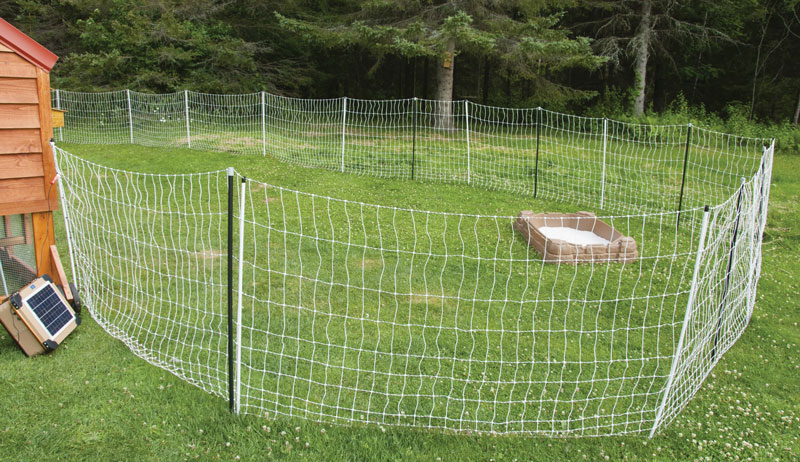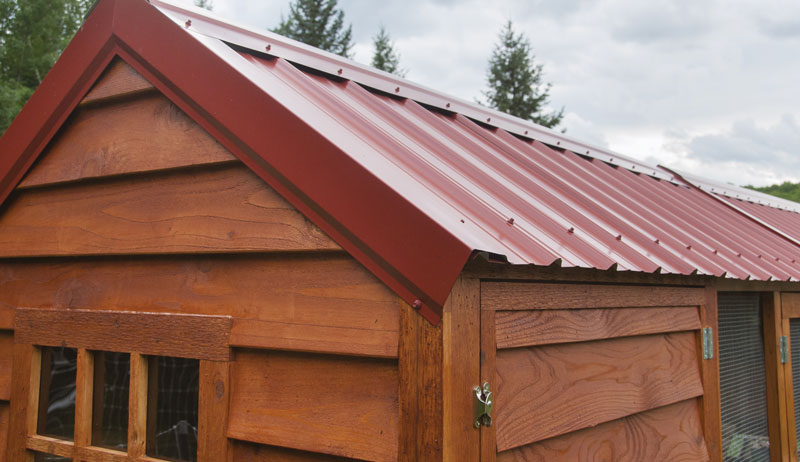
As farmers, we know that the animals must come first. We get up early if the barn chores are waiting. We head to the chicken coop to feed the birds before we feed ourselves. It’s just part of the lifestyle, and it’s completely satisfying and understandable to those who live it.
So it should come as no surprise that farmers may also tend to spoil their animals when it comes to housing.
This actually makes a lot of sense when you think about it because well-designed and properly thought-out animal housing makes the farmer’s life better, too. The animals stay safe and are protected. And going the extra mile in design means that chores are more convenient, the work goes more efficiently and the entire process is more enjoyable.
And isn’t enjoyment really one of the main goals of small-scale farming?
To that end, let’s look at a few ways you can spoil your hens—and yourself!—by designing your ideal chicken coop. Of course, what’s ideal will vary from person to person, so we won’t dive into specific construction details. But think of this as an idea bank for your next design.
Let’s go!
Build from Experience
Sometimes a hobby farmer has experimented with keeping chickens on a very small scale and is now ready to upgrade. This is an excellent time to take the lessons you’ve learned from your first chicken coop and apply them to the new design.
Ask yourself these questions:
- Was the coop door just too short?
- Did the angle of the clean-out door make for aggravating or uncomfortable work conditions?
- Were the nest boxes inconveniently located?
- Did the whole structure lack adequate ventilation?
- Was it built in a poor location for drainage, wind or sun exposure?
All of this experience can be very beneficial in moving forward on your new coop design. Choose the right location, far enough away from the house to control odors but not too far away from a water source.
Include enough ventilation—a square foot per chicken or at least 1⁄5 the coop’s wall space—to prevent excess ammonia smells and other unwanted gases. Make the coop comfortable to work in.
Read more: An automatic chicken coop door provides flexibility for chicken keepers.
Square Footage Vs. No. of Birds
All things being equal, a coop with more square footage is probably nicer! And if the goal is really to build your ideal coop, explore designs with larger footprints. Keep in mind that more square footage is more space to clean. But that may not be a large concern.
If you’re building a new coop because you’d like to increase the size of your flock, figure that each bird should generally have about 3 to 4 square feet of interior space. But bigger is always better (within reason).
Figure on even more square footage for regions with hard winters where the chickens might spend more time indoors.
Hardware Cloth
Experienced chicken owners probably already know this, but chicken wire—that familiar, flexible, hexagonal, woven wire—isn’t a very strong barrier. Determined predators can tear it down, so another method is needed.
Popular alternatives include hardware cloth, which is a similar idea but constructed out of a much stronger wire. You’ll find this in 1/2- or 1⁄4-inch sizes, either of which could function well for a chicken coop.
Those extra (and now unused!) rolls of chicken wire you have stashed away can be better put to use as a way to control the movement of—or confine —chickens within the safety of an already secure area.
You can isolate a broody hen or otherwise limit interactions between members of the flock, both inside the coop or outside in the run.
Roosts Aren’t Just for Roosters
Regardless of whether your flock contains just hens or includes a rooster or two, you’ll want to make sure that your coop has enough roost space.

A few dos and don’ts regarding roosts include:
- Do provide your hens with enough roosting space. Figure on 12 inches per bird.
- Don’t build the roosts over the nest boxes!
- Do provide wooden, somewhat rounded roosts that are at least 2 inches wide.
- Don’t use metal roosts (frostbite potential!).
- Do stagger the roosts to gain extra height and space.
Electricity
Of course, if you’re really serious about creating an ideal coop, consider adding electricity to it. You have a couple of different options here. While running a buried power line from the house or barn to the coop is certainly doable, this might be more effort or expense than you’re willing to invest even in an ideal coop.
Extension cords running across the top of the ground aren’t ideal or particularly safe. Happily, technology has made it easier (and less expensive) than ever to supply electrical conveniences to an “off the grid” coop—even if it’s only a couple hundred feet off the grid.
Modern small solar panels are capable of powering:
Lights
LED lights are energy-efficient, so they’re useful in a solar-powered coop setting. They’re also purportedly effective in cold weather, so that’s a plus, too.
Not only are lights useful for when you’re working in the coop after-hours, they may be a necessity if you’re trying to extend your hens’ laying season. (Egg production and hours of daylight go hand-in-hand.)
You might also want to install some outdoor lights for dawn or dusk work.
Electric Fencing
Solar-powered fence chargers are more than capable of providing power for a basic (and fairly large) chicken-safe electric fence run for daytime use.

Electric fencing can also act as a helpful deterrent for keeping snooping predators away from the chicken coop.
Timers
Want your flock safely inside the coop at night, but don’t necessarily want to wake up early every morning to let them out? Install an electric timer on a chicken door to easily let the hens out each morning.
For all their benefits, there are some things that solar panels just won’t have enough electricity to power. A major one of these is heat, which uses up a consider amount of electricity. If you live in a region with considerably harsh and cold winters, you may need to consider heating your chicken’s water source. For that, you’ll probably want your coop connected to the grid.
Nest Boxes
Picture this: It’s a cold, wet, muddy spring day, and you’re on your way to the coop for the morning’s egg collection. Do you really want to juggle your egg basket and your muck boots while opening the door, trying to keep all your hens from getting out while you enter the coop to get the eggs?
No way!
A much more convenient plan is to construct nesting boxes that can be accessed from the outside of the coop. A simple (yet weatherproof) access door is all that you’ll need to be able to collect eggs from the outside.
If you’d like more square footage inside the coop for the birds, you could build the nest boxes in their own section that juts out from the main body of the coop. But, again, this will need to be carefully weatherproofed.
Nest boxes are really the key to keeping your eggs clean and safe. They encourage the hens to nest in the designated location and not somewhere else—such as the coop floor! Nest boxes should be about 1 cubic foot of space—maybe a little taller.
And remember that not all the hens need a specific nest box. They’ll share, and you only need one nest box per three to four hens.
Read more: What should you do when a hen breaks an egg?
Clean-up Time
Just as outside access makes it easy to collect eggs, outside access is also important for efficient coop clean up. Poultry are … well, messy, and with dribbled bits of feed, loose feathers, used bedding and manure, cleaning out the coop regularly is a necessity.
Planning ahead during the construction process and designing the coop so that it is easy to clean saves time and effort later.
Figure on including an outside access door that will allow for at least basic daily clean-outs, and perhaps an additional, larger access door that provides admission for “ big-time, all-out, hose-it-down-and-remove-everything” cleaning days.
Some folks like to include a linoleum floor for easy clean up.
Roofing 101
Looking for a roof that won’t tax your carpentry skills? Figure on building a shed roof.

Want something that can hold up to a higher snow load and offers some additional ventilation options? Consider a gable roof.
Either style can be effective, as can the choice of a metal roof versus shingles. Metal roofs last, look good and shed snow loads effectively. They can also be noisy during heavy rainfalls.
Shingles look good but might not be quite as durable in the long run.
Enjoy the Process
Make your coop designing and building process fun! Instead of a bare-bones design, splurge on your ideal coop in ways that won’t significantly add to the cost.
Attractive painting on the trim or siding doesn’t cost much except your time to do it, but it can significantly add to the long-term aesthetic appeal of your coop.
Even for a large chicken coop, the actual square footage of the walls isn’t too much. You could try siding it with cedar shakes or another type of siding that you find appealing. (How about a log-siding “cabin” coop?!). Add some decorative touches!
Most of all, enjoy the process.
Sidebar: Permits for Poultry
Research ahead of time whether or not you’ll need to apply for a building permit before you begin constructing a chicken coop.
The answer is always dependent on your specific location and town/city ordinances. But it’s possible that the small footprint of your coop will be enough to keep it under the dimensions that require a permit.
Also, it might be possible that a coop without a true foundation will be exempt from the permitting process. On the other hand, if a permit is required, keep in mind that there may be certain parameters required regarding size, height, windows, placement on the property and more.
While you’re at it, make sure no specific ordinances exist about keeping chickens to begin with! This is probably more of a concern in a more urban-farming situation where there might be local concerns about noise from roosters or the size of the chicken flock.
Still further, you might discover local ordinances detailing storage of chicken feed sources, how to control chicken manure, etc.
Hopefully, you live in location where chicken-keeping is welcome, and, permit or not, you have a positive coop-building experience.
This article originally appeared in the January/February 2021 issue of Chickens magazine.




